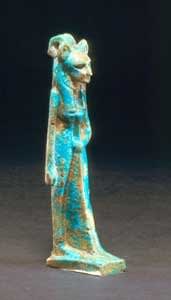26th Dynasty Faience Amulet of Sekhmet, 1070 CE - 712 CE
Faience
3.5
X.0329
The first examples of amulets appeared in Ancient Egypt as early as 4000 B.C. Believed to possess magical powers that protected the wearer or bestowed upon the properties they symbolized,...
The first examples of amulets appeared in Ancient Egypt as early as 4000 B.C. Believed to possess magical powers that protected the wearer or bestowed upon the properties they symbolized, amulets were worn both by the living as well as the dead. Throughout their evolution, talismans were crafted from a variety of materials including precious metals such as gold and silver, semiprecious stone like jasper and carnelian, as well as other more affordable glazed compositions such as faience. The particular powers of an individual amulet were based upon its specific shape, although the material and even the color of the charm could affect its magical abilities. While many of the amulets created to be worn by the living could also be worn after death, there also existed a specific group of charms that were made specifically to be placed upon the mummified remains of the deceased. All together, amulets represent an important class of Ancient Egyptian art that furthers our understanding of their complex religious beliefs.
Faience, which dates back to predynastic times, at least 5,000 years, is a glasslike non-clay substance made of materials common to Egypt: ground quartz, crushed quartz pebbles, flint, a soluble salt-like baking soda, lime and ground copper, which provided the characteristic color. The dried objects went into kilns looking pale and colorless but emerged a sparkling "Egyptian blue." Called tjehnet by the Ancient Egyptians, meaning that which is brilliant or scintillating, faience was thought to be filled with the undying light of the sun, moon and stars and was symbolic of rebirth. Ancient Egyptians believed the small blue-green objects helped prepare them for eternity in the afterlife.
Sekhmet, along with her husband the creator-god Ptah and their son Nerfertum, was part of the powerful trio of deities that protected Ancient Memphis. Daughter of the sun god Ra, her name literally means, “the powerful.” She was a sun goddess, embodying the scorching, burning, destructive heat of the sun. Fierce goddess of war, the destroyer of the enemies of Ra and Osiris, she was represented as having the head of a lioness and the body of a female human. She quickly became a favorite of the pharaohs, symbolizing their strength and heroism in battle. In fact, in one treatise on kingship dated to the Middle Kingdom, the harsh punishment of the pharaohs against anyone who rebelled or opposed him was compared to the wrath of Sekhmet. Like the sun, her temper was uncontrollable. In the legend Hathor, Sekhmet's anger became so great, she would have slaughtered the entire human race if Ra had not taken pity on us and concocted a scheme to make her drunk. Yet her warlike nature, she also played a role as a healer in certain ritual contexts.
Faience, which dates back to predynastic times, at least 5,000 years, is a glasslike non-clay substance made of materials common to Egypt: ground quartz, crushed quartz pebbles, flint, a soluble salt-like baking soda, lime and ground copper, which provided the characteristic color. The dried objects went into kilns looking pale and colorless but emerged a sparkling "Egyptian blue." Called tjehnet by the Ancient Egyptians, meaning that which is brilliant or scintillating, faience was thought to be filled with the undying light of the sun, moon and stars and was symbolic of rebirth. Ancient Egyptians believed the small blue-green objects helped prepare them for eternity in the afterlife.
Sekhmet, along with her husband the creator-god Ptah and their son Nerfertum, was part of the powerful trio of deities that protected Ancient Memphis. Daughter of the sun god Ra, her name literally means, “the powerful.” She was a sun goddess, embodying the scorching, burning, destructive heat of the sun. Fierce goddess of war, the destroyer of the enemies of Ra and Osiris, she was represented as having the head of a lioness and the body of a female human. She quickly became a favorite of the pharaohs, symbolizing their strength and heroism in battle. In fact, in one treatise on kingship dated to the Middle Kingdom, the harsh punishment of the pharaohs against anyone who rebelled or opposed him was compared to the wrath of Sekhmet. Like the sun, her temper was uncontrollable. In the legend Hathor, Sekhmet's anger became so great, she would have slaughtered the entire human race if Ra had not taken pity on us and concocted a scheme to make her drunk. Yet her warlike nature, she also played a role as a healer in certain ritual contexts.



